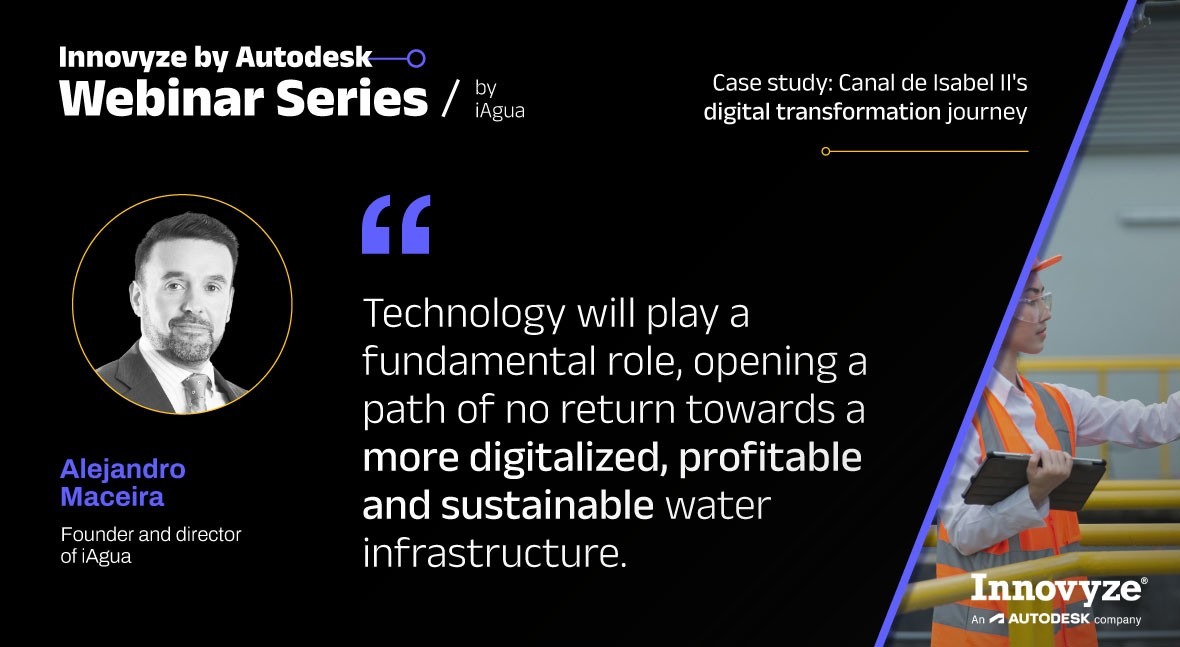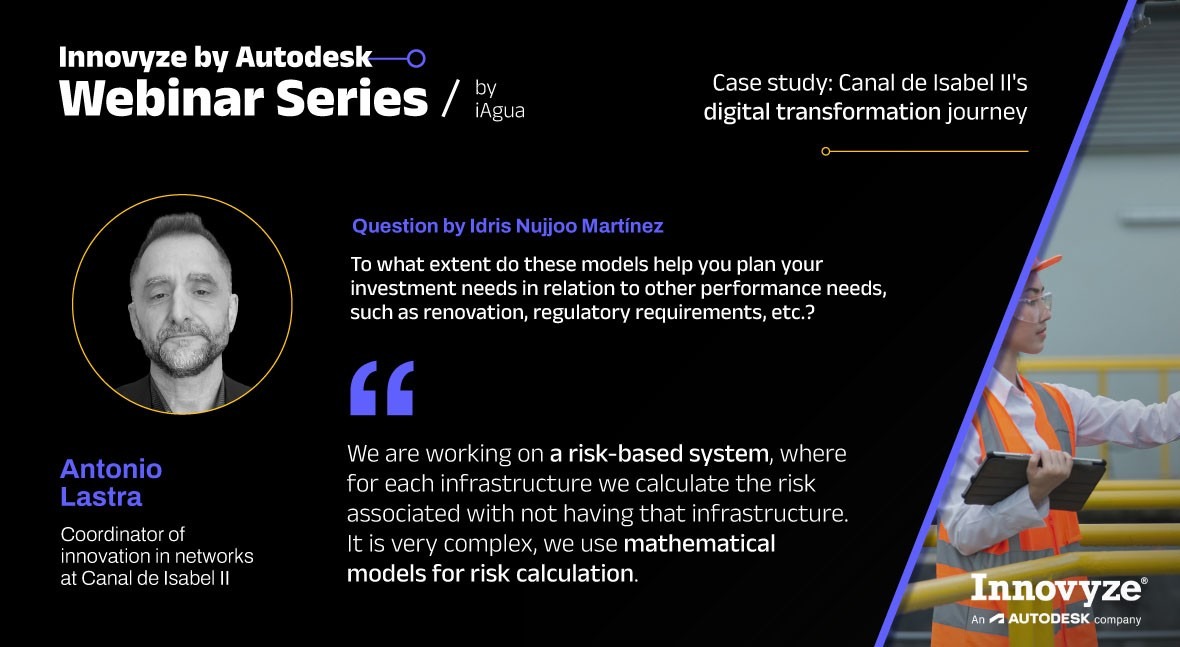Innovyze accompanies Canal de Isabel II on its journey towards digital transformation

On Thursday, October 6th, Innovyze by Autodesk organized a webinar with iAgua to discuss in depth the digitalization of the water industry. The event aimed to show how technological innovation transforms water management in municipalities, their consultants and contractors.
This particular webinar focused on digitalization and water utilities. To cope with trends such as urban population growth, threats such as climate change and ageing infrastructure, and changes in the regulatory framework and budget availability, managers are now forced to focus on innovation and readjust their status quo. This is where Innovyze, a global leader in the creation of cutting-edge software for the water sector for more than 35 years, comes in, fully committed to developing technology that enables more sustainable water use, offering the solutions needed for safe drinking water supply and sanitation.
Alejandro Maceira, founder and director of iAgua, presented the webinar and highlighted that "technology will play a fundamental role, opening a path of no return towards a more digitalized, profitable and sustainable water infrastructure". After this, he introduced the protagonist of this webinar: Canal de Isabel II, the water utility providing services in the region of Madrid, Spain.
Antonio Lastra, coordinator of innovation in networks at Canal de Isabel II, where he directs research and innovation projects in the field of the urban water cycle, explained the reality of the company and its digital transformation journey: "Today we are going to share a part of this digital transformation, the part that has to do with mathematical models; we will focus on network models, which is the Innovyze solution". In this regard, he pointed out that they need "help with planning, studies and operation, and this is where mathematical models play an important role".
Next, the coordinator of network innovation at Canal de Isabel II spoke about the different models the company uses to manage water: "There are four aspects in which we use the software: drinking water models, urban drainage network models, and we have also modelled floods and discharges". Regarding the drinking water network model, INFOWORKS WS, Lastra stressed that Canal de Isabell II can reduce costs and improve service with comprehensive, reliable and collaborative water distribution analysis and modelling, which includes a strategic network and detailed network.
Canal de Isabel II uses InfoWorks ICM, the world's leading sewer modelling software
The company also uses InfoWorks ICM, the world's leading sewer modelling software. This model has enabled Canal Isabel II to better meet its water modelling requirements and ensure quality performance for the city of Madrid. "In urban drainage networks we ask for a lot of precision, what we want is an idea of more or less what is going to happen", he said. In addition, this software has a 2D variant that is used for decision-making and the risk-based flood early warning system that covers the entire urban area of the Community of Madrid and analyses flood zones. "We model in 2D to know the depth, speed and duration of the floods and our discharges", he said, so that they can estimate the magnitude of the flood and anticipate what is going to happen.
Canal de Isabel II is also implementing water quality models with this software: "We intend to carry out a study of the wastewater of Madrid, the wastewater we all generate and we treat to return it to the rivers, with reduced or even improved quality, as the health authorities demand".
Finally, regarding the next steps that Canal de Isabel II plans to take, Antonio Lastra commented that the utility wants to increase the 3D models they have with the software they are currently using: "We want to take the mathematical model of drinking water to an almost real-time scale, what is now being called the digital twin".
All in all, Canal de Isabel II has begun an innovative digital transformation journey in which Innovyze's digital water solutions help drive its vision of a smart water future to improve both planning and operational efficiency. Then, Idris Nujjoo Martínez, Solutions Engineer in Asset Management at Innovyze by Autodesk, spoke to Antonio Lastra about the impact of Innovzye's solutions on Canal de Isabel II's water management model. Regarding the way in which these have benefited the water supply and wastewater services for end customers, Antonio Lastra pointed out that with the mathematical models they are seeking improvements in planning and operation: "Improving the efficiency of the drinking water and drainage networks benefits all residents in Madrid."

He also spoke of the benefits of having mathematical models, focused on efficiency: "The efficiency of an infrastructure is not only the network; it has two aspects: technical efficiency of services as a public utility - meeting high quality standards - and economic efficiency". Furthermore, regarding Innovyze's technical services, he pointed out that Canal de Isabel II has expert modellers in-house, "but then there is a part of the implementation of all the possibilities of the model that are not always so obvious" and, for this, they have the help of Innovyze.
Alejandro Maceira then asked some questions from the audience. One of the questions was how Canal de Isabel II has solved the modelling of WWTP water quality at a software level, with comprehensive planning in mind. Antonio Lastra answered that they are making a detailed localised hydraulic model to be able to analyse how all the elements of a WWTP work, but that these models "still have a long way to go". Likewise, on the efficiency achieved with the modelling of the drinking water supply network, he pointed out that their drinking water network is too complex, with 18,000 kilometres of network, and that it is difficult to carry out a complete efficiency analysis: "In small networks it is possible to analyse efficiency, the improvement in economic performance by reducing electricity consumption, or water losses, leaks and so on".
Another question from the audience was how many years it has taken to model the drinking water and drainage networks. Regarding the former, Antonio Lastra commented that it has taken "many, many years" and that it has been a long process because it has been improved as it went along. However, the modelling of the drainage network has been done more recently, starting in 2006. The greatest challenge, in this case, was modelling the topography: "If we don't have the topography well resolved, there is no software that can fix that".
Finally, Antonio Lastra spoke about the PERTE on Digitalization: "The fundamental challenge, and this is what the PERTE will allow us to do, is to invest not only in proper monitoring, which is necessary, especially in the case of drainage, but also to invest in data processing in order to do useful things with the data". He mentioned the three main areas of the water sector on which it will have the greatest impact: firstly, remote reading "so that we know people's consumption and people know their own consumption", he said; secondly, the monitoring of urban drainage elements; and lastly, data analysis: "If we don't know what to do with the data, it is not worth anything more than saying that you have it".








